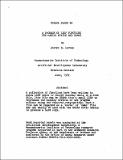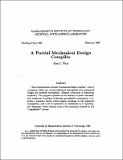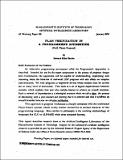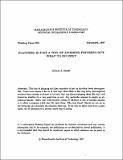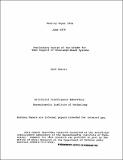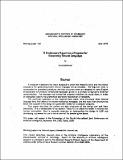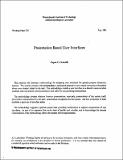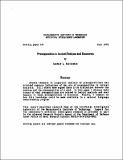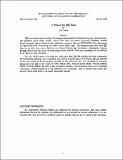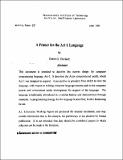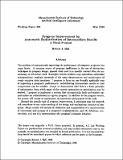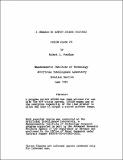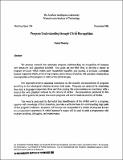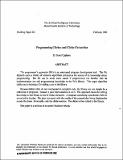Browsing AI Working Papers (1971 - 1995) by Title
Now showing items 171-190 of 291
-
A Package of LISP Functions for Making Movies and Demos
(MIT Artificial Intelligence Laboratory, 1972-06)A collection of functions have been written to allow LISP users to record display calls in a disk file. This file can be UREAD into a small LISP to reproduce the display effects of the program without doing the required ... -
Parallel Flow Graph Matching for Automated Program Recognition
(MIT Artificial Intelligence Laboratory, 1988-07)A flow graph matching algorithm has been implemented on the Connection Machine which employs parallel techniques to allow efficient subgraph matching. By constructing many different matchings in parallel, the algorithm is ... -
A Partial Mechanical Design Compiler
(MIT Artificial Intelligence Laboratory, 1987-02)I have implemented a simple "mechanical design compiler", that is a program which can convert high-level descriptions of a mechanical design into detail descriptions. (Human interaction is sometimes required.) The program ... -
Plan Recognition in a Programmer's Apprentice
(MIT Artificial Intelligence Laboratory, 1977-05)Brief Statement of the Problem: Stated most generally, the proposed research is concerned with understanding and representing the teleological structure of engineered devices. More specifically, I propose to study the ... -
Plan Verification in a Programmer's Apprentice
(MIT Artificial Intelligence Laboratory, 1978-01)Brief Statement of the Problem: An interactive programming environment called the Programmer's Apprentice is described. Intended for use by the expert programmer in the process of program design and maintenance, the ... -
Planning is Just a Way of Avoiding Figuring Out What To Do Next
(MIT Artificial Intelligence Laboratory, 1987-09)The idea of planning and plan execution is just an intuition based decomposition. There is no reason it has to be that way. Most likely in the long term, real empirical evidence from systems we know to be built that way ... -
A Planning System for Robot Construction Tasks
(MIT Artificial Intelligence Laboratory, 1973-05)This paper describes BUILD, a computer program which generates plans for building specified structures out of simple objects such as toy blocks. A powerful heuristic control structure enables BUILD to use a number of ... -
The Position of the Sun
(MIT Artificial Intelligence Laboratory, 1978-03)The appearance of a surface depends dramatically on how it is illuminated. In order to interpret properly satellite and aerial imagery, it is necessary to know the position of the sun in the sky. This is particularly ... -
Preliminary Design of the APIARY for VLSI Support of Knowledge-Based Systems
(MIT Artificial Intelligence Laboratory, 1979-06)Knowledge-based applications will require vastly increased computational resources to achieve their goals. We are working on the development of a VLSI Message Passing Architecture to meet this need. As a first step we ... -
A Preliminary Report on a Program for Generating Natural Language
(MIT Artificial Intelligence Laboratory, 1975-06)A program framework has been designed in which the linguistic facts and heuristics necessary for generating fluent natural language can be encoded. The linguistic data is represented in annotated procedures and data ... -
Presentation Based User Interfaces
(MIT Artificial Intelligence Laboratory, 1981-07)This research will develop a methodology for designing user interfaces for general-purpose interactive systems. The central concept is the presentation, a structured pictorial or text object conveying information about ... -
Presupposition in Lexical Analysis and Discourse
(MIT Artificial Intelligence Laboratory, 1975-07)Recent research in linguistic analysis of presuppositions has provided numerous indications of the role of presupposition in lexical analysis. Still others have argued there is no distinction between meaning and the ... -
A Primer for TEX Users
(MIT Artificial Intelligence Laboratory, 1982-03)TEX is our latest text formatter. It is designed specifically for technical text (e.g., mathematics), and produces much higher quality output than other formatters previously available. Donald Knuth designed TEX at Stanford ... -
A Primer for the Act-1 Language
(MIT Artificial Intelligence Laboratory, 1981-06)This document is intended to describe the current design for computer programming language, Act-1. It describes the Actor computational model, which Act-1 was designed to support. A perspective is provided from which to ... -
Principles of Knowledge Representation and Reasoning in the FRAPPE System
(MIT Artificial Intelligence Laboratory, 1989-05)The purpose of this paper is to elucidate the following four important architectural principles of knowledge representation and reasoning with the example of an implemented system: limited reasoning, truth maintenance, ... -
A Program Design Assistant
(MIT Artificial Intelligence Laboratory, 1989-06)The DA will be a design assistant which can assist the programmer in low-level design. The input language of the DA is a cliché-based program description language that allows the specification and high-level design of ... -
Program Improvement by Automatic Redistribution of Intermediate Results
(MIT Artificial Intelligence Laboratory, 1988-05)The problem of automatically improving the performance of computer programs has many facets. A common source of program inefficiency is the use of abstraction techniques in program design: general tools used in a specific ... -
A Program to Output Stored Pictures
(MIT Artificial Intelligence Laboratory, 1972-06)A program called LPTSEE has been written for use with the MIT vision system. LPTSEE makes use of the overprint capability of the line printer to allow the user to output a stored picture image. -
Program Understanding through Cliché Recognition
(MIT Artificial Intelligence Laboratory, 1981-12)We propose research into automatic program understanding via recognition of common data structures and algorithms (clichés). Our goals are two-fold: first, to develop a theory of program structure which makes such recognition ... -
Programming Cliches and Cliche Extraction
(MIT Artificial Intelligence Laboratory, 1982-02)The programmer's apprentice (PA) is an automated program development tool. The PA depends upon a library of common algorithms (cliches) as the source of its knowledge about programming. The PA can be made more usable if ...

